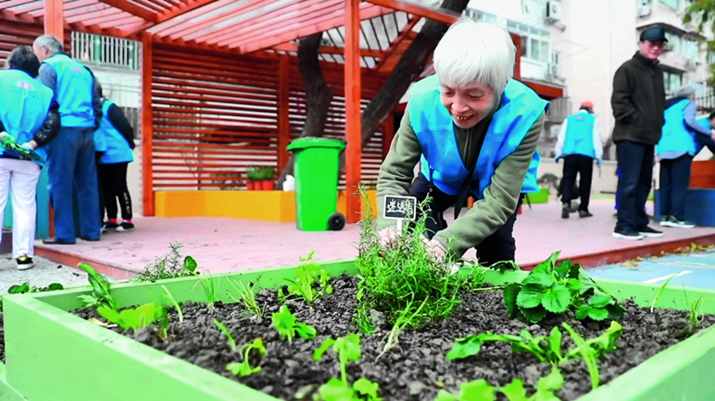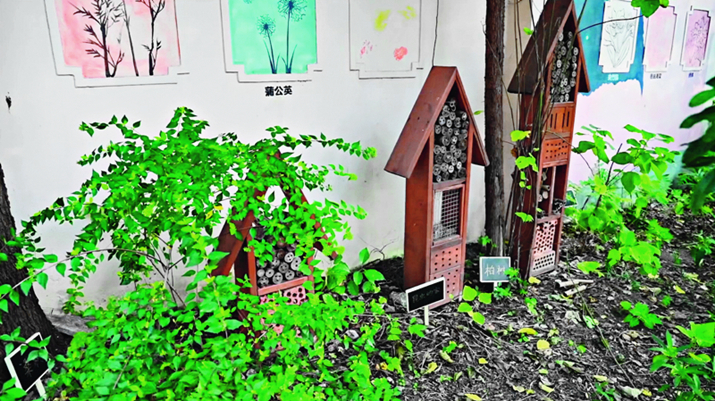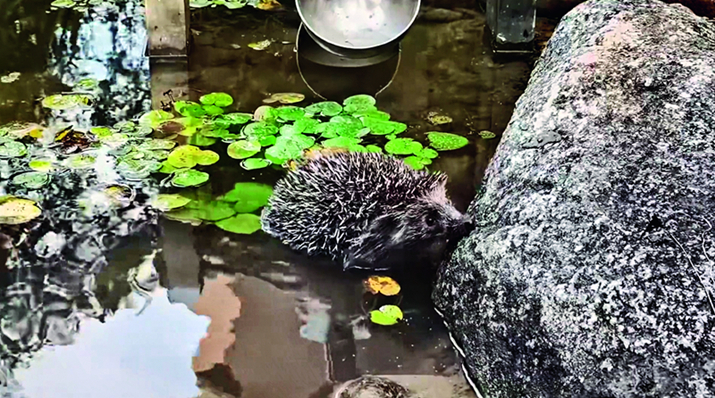|
||||||||||
| Home Nation World Business Opinion Lifestyle ChinAfrica Multimedia Columnists Documents Special Reports |
|
||||||||||
| Home Nation World Business Opinion Lifestyle ChinAfrica Multimedia Columnists Documents Special Reports |
| ChinAfrica |
| A Natural Paradise |
| The transformation of an abandoned plot of land into a habitat garden brings residents closer to nature |
| Edited by Ge Lijun 丨VOL. 15 February 2023 ·2023-01-29 |

Residents grow new plants in a habitat garden in the Hongxu neighbourhood, Shanghai
Living in the middle of Shanghai among raccoon dogs, hedgehogs, and egrets while making friends with water fowl... Due to the development of habitat gardens, what previously seemed to be a pipe dream is now a reality that is playing out all around us every day.
A habitat garden mixes a communal garden with a refuge for animals. In comparison to a typical garden, it often features a wider diversity of native species. Numerous local birds, bees, and other wildlife can be attracted by a vast array of these plants.
As a pioneer in ecological restoration, Shanghai’s Changning District has built eight habitat gardens in different communities. Turning wasted space into a new haven for both man and nature, habitat gardens naturally contribute to urban regeneration.

A corner in a habitat garden in the Hongxu neighbourhood, Shanghai
A second life
Even though most habitat gardens are just a few hundred square meters in size, these tiny havens are nonetheless important.
Before people transformed it into a habitat garden, the 732-square-meter area in Changning’s Xiehe Jiayuan (meaning a harmonious community in Chinese) was an abandoned, unmanaged public area. The garden was showcased at the the 15th meeting of the Conference of the Parties to the Convention on Biological Diversity (COP15), which was held in Kunming, Yunnan Province, in 2021, as a model of biodiversity throughout the world.
The largest garden of its sort in Shanghai is the Xiehe Jiayuan Habitat Garden. Raccoon dogs, Siberian mink, red-bellied squirrels, and hedgehogs - all native Shanghai wildlife - have established homes there in a short time since it opened.
All neighbourhood residents can benefit from these compact green areas, which were created using native flora. They are developed with the active involvement of locals and in close collaboration with the community.
Senior agronomist Ma Kun from the Shanghai Academy of Agricultural Sciences frequently instructs community volunteers on how to distinguish between native and invasive alien species as well as how to maintain their gardens. Ge Zhaohong, a 76-year-old resident who is aware of the risks posed by invasive species, assembled a number of senior citizens into a group of volunteers who work every day in the garden to clear out trash and unwanted plants.
In fact, this approach, which is shared by the residents and combines biodiversity protection with community landscaping, was developed three years ago in a neighbourhood 3 km away.
The 450-square-metre Hongxu Habitat Garden was once a storage area for rubble and waste. It now houses native plants, ponds, vegetable gardens, children’s playgrounds and a pavilion. According to statistics, there are currently more than 70 species of plants cultivated in the habitat garden.
Wu Hongping, secretary of Hongxu Community General Branch of the Communist Party of China, was committed to transforming the neighbourhood when the community started a reconstruction project in 2018. Wu learnt that many of the locals desired to convert the space into a small garden. She later found out via a site assessment that the location was adjacent to the Shanghai Zoological Park where birds occasionally stopped by to rest. Could we offer a place for little creatures to live? Since then, the thought has occurred to her to design a garden with a whole ecology. Shanghai’s first habitat garden finally opened in 2019, much to the residents’ delight, after a year of construction.
What needs to be done to maintain the garden once it is finished? The residents formed a volunteer group which regularly help to maintain the habitat garden. Over the past few years, the number of volunteers has increased from 14 to 21. Every day, the garden is maintained by a volunteer who prunes the flowers and trees, renovates the soil of the flower boxes and removes silt from the pond. They maintain the garden soil using kitchen compost.
One of them is local Li Defu. He, along with other volunteers and the kids, deliver the fruit that has been picked as gifts to the elderly residents of the neighbourhood who live alone whenever the plants they nurture yield fruit. Wax gourd, bok choy, and asparagus lettuce... Giving and being kind have bonded neighbours year after year, eventually becoming a tradition in the neighbourhood.
The Hongxu Residents’ Committee frequently hosts training sessions to further educate locals about fauna and flora. A specialist from Shanghai Jiaotong University was once called by the committee to give a captivating talk on water plants. As residents become more enthusiastic about exploring nature, more and more elderly people are getting out of their homes and participating in the daily management of the habitat garden, which not only adds colour to their retirement life, but also allows them to meet new friends.
The Hongxu Community is known for its commitment to micro urban renewal, which is a leader in waste classification, composting and recycling. It is an important example of how to integrate nature into a community.

A hedgehog is seen in a habitat garden in the Xiehe Jiayuan neighbourhood, Shanghai
Urban regeneration
Projects like those in Xiehe Jiayuan and Hongxu are a part of Shanghai’s efforts at urban renewal. Urban regeneration, also known as urban renewal, recovers underutilised assets and redistributes possibilities, therefore boosting urban prosperity and quality of life, according to the United Nations.
Six additional habitat gardens were constructed in 2021 with assistance from the Changning district government. About 30 habitat gardens are planned for construction in Changning as part of the 14th Five-Year Plan (2021-2025), which is intended to create a network of habitats and enhance the functionality and quality of the urban ecological area.
Changning’s habitat gardens, a pioneer in ecological restoration, have transformed more than 3,500 square metres of road surfaces in residential communities into fertile soil for plants and wildlife. The figure may not be statistically significant, but every little step counts as Shanghai strives to become an environmentally habitable city by 2035.
The creation of habitat gardens was formally incorporated by the city in August 2022 into its most recent draft ecological improvement plan. The Shanghai Territory Ecological Restoration Plan (2021-2035) states that habitat gardens offer a haven for animals and opportunities for outdoor leisure for locals, and therefore are crucial for biodiversity protection in the city.
|
||
| About Us | Contact Us | Advertise with Us | Subscribe |
| Copyright Beijing Review All rights reserved 京ICP备08005356号-5 京公网安备110102005860号 |